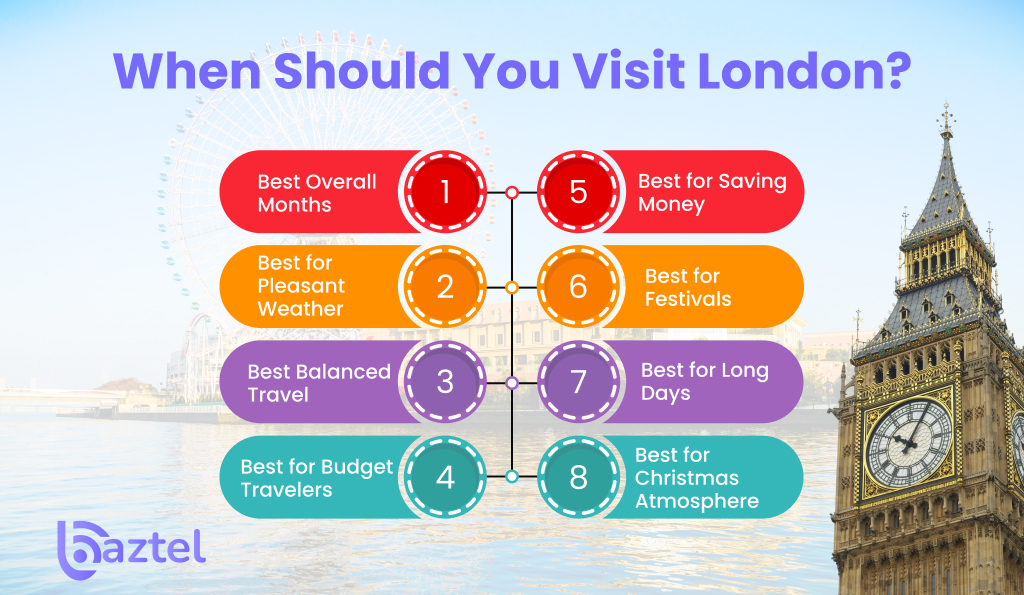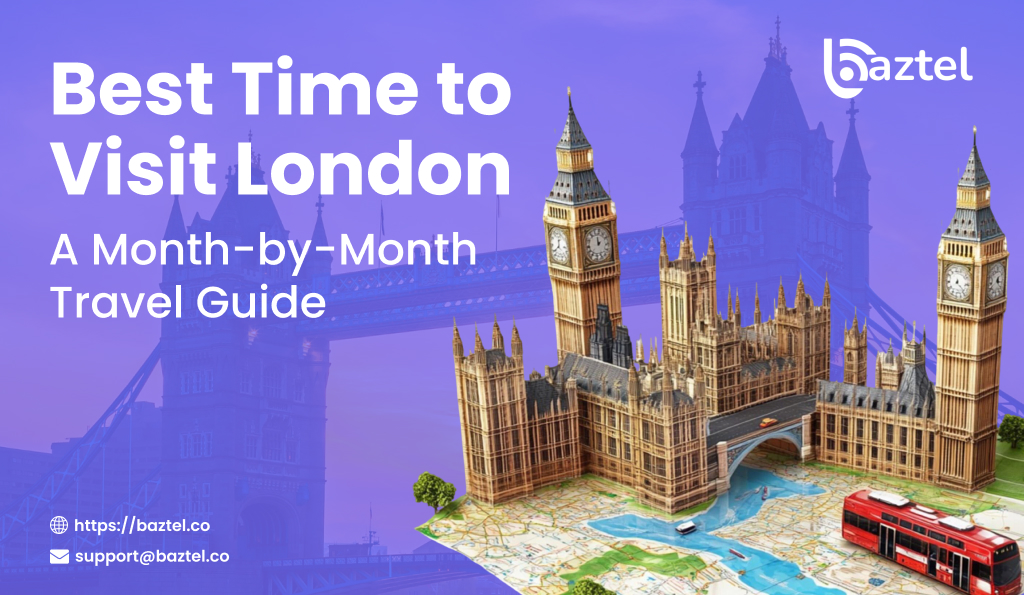London is a city that vibrates with life and energy no matter what time of the year it is, but still, your enjoyment may turn out to be completely different depending on the time you stroll around. From riverside walks basking in the sun to marketplaces popular in winter, selling popular Christmas articles, London enjoys this transformation every month, and thus each season gets its own identity. Therefore, being familiar with the Best Time to Visit London is one of the very clever decisions that you can make prior to booking your flights.
The city’s climate is notorious for its fickleness, but the rule of the city’s life is strict. The number of tourists peaks in summer, prices for hotels double at Christmas, and spring is when parks bloom with colors that cannot be found anywhere else. Whether you are organizing your first trip or you are going to visit again to get into the secret places, being familiar with London weather month by month allows you to pick the best timing to experience the city the way you like.
This blog provides a comprehensive overview of everything you need to know before visiting, including the best seasons, the ideal months for sightseeing, cheap travel periods, and when London hosts its most iconic events. To make your planning even simpler, a detailed table of each month comparing weather, crowds, highlights, and drawbacks is also provided so as to give you a clear view of what every month has to offer long before setting foot in London.
Which Is the Best Season to Visit London?
London’s summer season is full of action with main happenings, autumn provides a pleasant London climate and rich culture, and winter brings the joy of holidays along with excellent budget offers. The difference in seasons brings out the various characteristics of the city, thus assisting tourists in the decision of the Best Time to Visit London.
1. Spring (March–May): Best Overall Season
Spring in London just feels right. The city wakes up parks and gardens burst into color, and that chill in the air isn’t too much. It’s usually somewhere between 9 and 17 degrees, so you can walk for ages or spend the whole day outside without feeling worn out. Hyde Park, Kew Gardens, and St. James’s Park all look their best now.
A lot is going on too. The Chelsea Flower Show, the Boat Race, and food and arts festivals breathe life into London, but it is not yet overcrowded with tourists. Of course, there is an increase in the number of visitors as spring comes to an end, but it is still much quieter than summer. Hotels won’t empty your wallet, and with the sun setting late, you’ve got extra time to get lost in the city.
Best for: Sightseeing, photography, families, first-time visitors
Downside: Occasional spring showers
2. Summer (June–August): Best for Events and Outdoor Activities

Energy level of summer in London is the highest. Daylight hours are extended, temperatures are cool (between 15°C and 24°C), and the city is very much alive with outdoor activities, resembling a massive festival. The peak period of street food markets, open-air cinemas, and concerts in London has been reached.
Wimbledon, Notting Hill Carnival (late August), British Summer Time concerts, and several cultural festivals are among the major events. The downside? It’s a period that is not only the busiest but also the most expensive. Prepare for long lines at tourist spots, very high hotel prices, and crowded public transportation.
Best for: Event lovers, families, nightlife, outdoor festivals
Downside: High prices, heavy crowds
3. Autumn (September–November): Best for Culture and Comfort
Autumn has all these elements that make the weather awesome, let you see fewer people, and let you experience the culture at its fullest. The temperature varies between 10°C and 20°C, and the city is decking itself out with the amber leaves of autumn that make it a great day for a walk in Richmond Park, Hampstead Heath, or Kensington Gardens.
September is truly a summer month and full of life, whereas October and November are packed with warm and cozy cafes, food festivals, theater season, and also the very first Christmas lights. It is overcrowded already, so you can more frequently have the pleasure of shorter lines and hotel discounts.
Best for: Couples, budget-conscious travellers, culture lovers, photographers
Downside: Rain increases toward late autumn.
4. Winter (December–February): Best for Budget Travel (Except Christmas)

There are two sides to winter in London. The month of December is Christmas season and it is during this time that Christmas markets, skating rinks, Winter Wonderland and the Christmas lights of the shopping areas, such as Regent Street and Covent Garden, attract people.
The post-New Year period and London become one of the most economical places to visit in Europe. The months of January and February offer the cheapest accommodation, calm streets, and limited visitors. The cold is noticeable (2° to 8°C), but with proper clothing, one can still enjoy winter.
Best for: Budget travellers, museum lovers, festive season enthusiasts
Downside: Cold weather, short daylight hours
Month-by-Month Overview
A year in London is presented in a brief monthly overview. The table presents the weather, the number of tourists, the main pros and cons, and the things to be careful with, which makes it easier to pick the optimum time for your trip to London according to your travel style.
| Month | Weather | Crowds | What’s Great | Downsides |
| January | 2–8°C | Very Low | Cheapest hotels, quiet museums | Cold, short days |
| February | 2–8°C | Low | Romantic season, theatre deals | Grey weather |
| March | 4–11°C | Low–Medium | Early spring blooms | Occasional rain |
| April | 6–13°C | Medium | Blooming parks, pleasant days | Easter crowds |
| May | 9–17°C | Medium | Best weather, long days | Prices rise |
| June | 13–20°C | High | Festivals and summer events | Expensive |
| July | 15–23°C | Very High | Longest days, lively atmosphere | Very crowded |
| August | 15–24°C | Very High | Notting Hill Carnival | Busy everywhere |
| September | 13–20°C | Medium | Great weather and events | Days shorten |
| October | 10–16°C | Low–Medium | Autumn colours, Halloween | More rain |
| November | 5–11°C | Low | Christmas lights begin | Chilly, grey |
| December | 2–8°C | High | Christmas markets and Winter Wonderland | High holiday costs |
So, When Should You Visit London?

Before you disappear from the earth, knowing the best time to visit London is really helpful because then you will have the trip of your life. Traveling to London in May and September are the most suggested periods by most people. London at its finest, an almost empty tourist scene, and comfortable temperatures all together bring a very nice combo. London in these months has nice weather, long days, and a less crowded atmosphere compared to summer.
Winter, particularly January and February, is the time when the cheapest offers on hotels and airfares can be found. It brings down the prices to the lowest levels, and thus, those months become the best choice for backpackers. If the other way around, i.e., the colorful side of London is your objective, then June-July are the days when the city has to be visited, as it has fairs, summer activities, and the longest daylight hours. City lovers can easily be won over in October when nature paints the world in its most colorful shades and parks and streets are dressed in autumn colors. In addition, if your personality is one that always wants to be where the most beautiful scenery is, then you have to come in December to see the Christmas lights, markets, and festivities.
- Best Overall Months: May and September offer the best combination of comfortable London weather, lighter crowds, and top events.
- Best for Pleasant Weather: May provides mild temperatures and blooming parks, making it one of the best months to visit London.
- Best Balanced Travel: September delivers warm days, manageable crowds, and great value, ideal for planning the Best Time to Visit London.
- Best for Budget Travelers: January is the cheapest month with low hotel and flight prices, perfect for affordable London travel.
- Best for Saving Money: February offers quiet streets, discounted stays, and fewer tourists, making it a strong budget-friendly choice.
- Best for Festivals: June is packed with major summer festivals and outdoor happenings, aligning with peak London events season.
- Best for Long Days: July has the longest daylight hours of the year, ideal for exploring the city from morning until late evening.
- Best for Christmas Atmosphere: December is perfect for experiencing London’s festive spirit, with Christmas markets, lights, and winter celebrations.
Stay Connected in London with eSIM
Good internet access is the key to a trouble-free journey to London. Whether it is the city navigation or making last-minute reservations, staying online is an absolute must for a travel experience free of any kind of trouble. By the use of an eSIM, you are able to have a fast and continuous internet connection throughout your entire stay from the very moment of your arrival without the inconvenience of having to locate a local SIM card or pay for roaming charges.
When exploring London, you’ll rely on your phone for almost everything, including
- Google Maps and TfL Underground routes to move around efficiently
- Restaurant reservations for the most visited places around the city
- Online tickets for attractions like London Eye or Tower of London
- Ride services like Uber and Bolt
- Hotel check-ins and virtual confirmations
eSIM makes staying connected simple and convenient. It offers:
- Instant QR code activation, so you’re online in minutes
- Affordable UK and Europe-wide data plans, perfect for multi-country trips
- Fast 4G/5G speeds throughout London
- No physical SIM card swapping, keeping your device hassle-free
- Zero roaming charges, helping you avoid unexpected bills
Simply buy your Baztel eSIM, take a picture of the QR code, and use the data of your choice without any delay at Heathrow, Gatwick, or any other London airport. There is no better or more convenient way for a traveler to keep in touch while in London.
Conclusion
Every season London is a very beautiful city, and the Best Time to Visit London largely depends on what kind of experience you want to have. Both spring and fall offer the nicest weather in London; therefore, travelers can experience cool temperatures and less crowded places, which are perfect for sightseeing, visiting parks, and taking casual walks in the city. The summer is a great time to visit London if you want to experience the city at its most vibrant because it is full of life and energy, the days are long and there are a lot of great events. But winter is actually the best time for those who want to travel cheaply, take delight in the Christmas markets, and go to the indoor attractions.
Planning your trip ahead is the right thing to do whatever season you choose, as it will give you the opportunity to make the most of your trip. Bringing weather-appropriate clothes, booking the attractions you won’t want to miss in advance, and using a reliable eSIM such as Baztel eSIM to stay connected throughout your trip are some of the ways you can get ready. With the perfect setup, your London travel guide turns into a leisurely, non-stressful and memorable experience.
FAQ’s
1. What is the best month to visit London?
May and September are the best months to visit London. They both provide good weather, fewer tourists, long daylight hours, and various events to choose from. These months have the perfect mix of comfort, low prices, and good sightseeing opportunities.
2. Is London expensive to visit?
London is an expensive city, particularly in the summer and December when tourism is at its highest. On the other hand, visiting in January and February will practically cut your expenses in half. The prices of hotels, airfares, and attractions are quite low, which is why this period is good for budget travelers.
3. When is the cheapest time to travel to London?
January and February are the cheapest months for a London trip. The prices of flights, hotels, tours, and attractions drop sharply after the festive season. The places are less crowded, so you would be able to see the main attractions more conveniently and save money at the same time.
4. Does London rain all year round?
It is not the case that London waters itself with continuous rain, but it’s often the case that every season can have showers of rain by surprise. Most of the time, the months with the highest rainfall are October and November, while spring and summer are the seasons that most of the time have nice days. A small waterproof jacket or an umbrella is always handy, and you will always be prepared for the weather that is not constant.
5. Is an eSIM necessary for visiting London?
An eSIM isn’t mandatory, but using a travel eSIM like Baztel makes your trip more convenient. It comes with instant activation and reasonable data, and there are no roaming fees. Being able to communicate helps with finding your way, making bookings, receiving transport updates, and talking during your trip.
Blog Author
Peter
Peter started BazTel.co to make mobile internet easier for travellers. He noticed how tough it was to find good network options while visiting new countries. That’s when he built BazTel — a place where anyone can buy eSIMs online without confusion or long steps. He believes tech should be simple and useful, not complicated. When he’s free, he likes to travel, test BazTel himself, and keep improving it based on real user problems.

 Botswana
Botswana Zambia
Zambia Congo
Congo Colombia
Colombia China mainland
China mainland Chile
Chile Chad
Chad Central African Republic
Central African Republic Canada
Canada Cameroon
Cameroon Cambodia
Cambodia Burkina Faso
Burkina Faso Bulgaria
Bulgaria Brunei Darussalam
Brunei Darussalam Brazil
Brazil Aland Islands
Aland Islands Bosnia and Herzegovina
Bosnia and Herzegovina Bolivia
Bolivia Belgium
Belgium Belarus
Belarus Bangladesh
Bangladesh Bahrain
Bahrain Azerbaijan
Azerbaijan Austria
Austria Australia
Australia Armenia
Armenia Argentina
Argentina Algeria
Algeria



